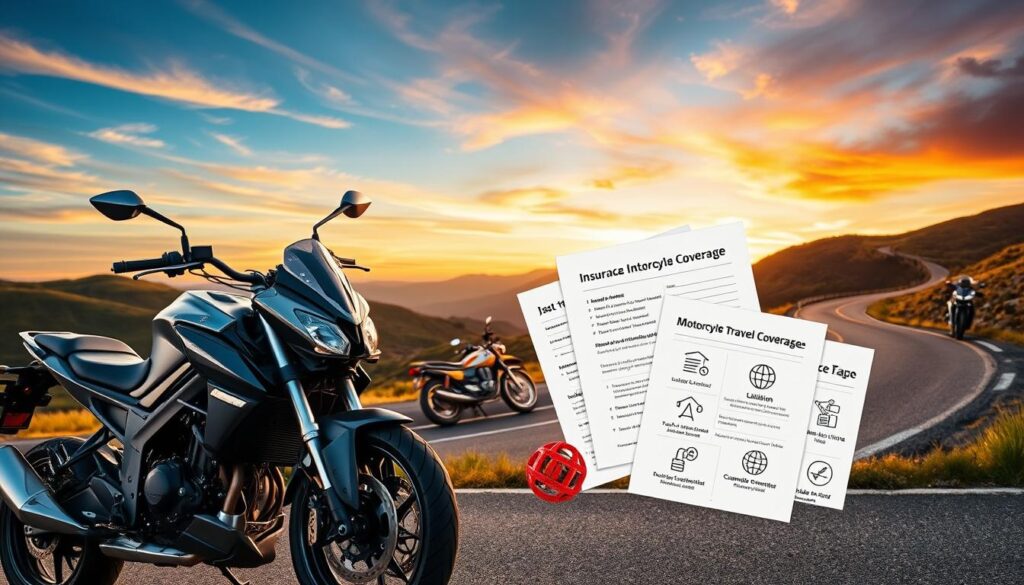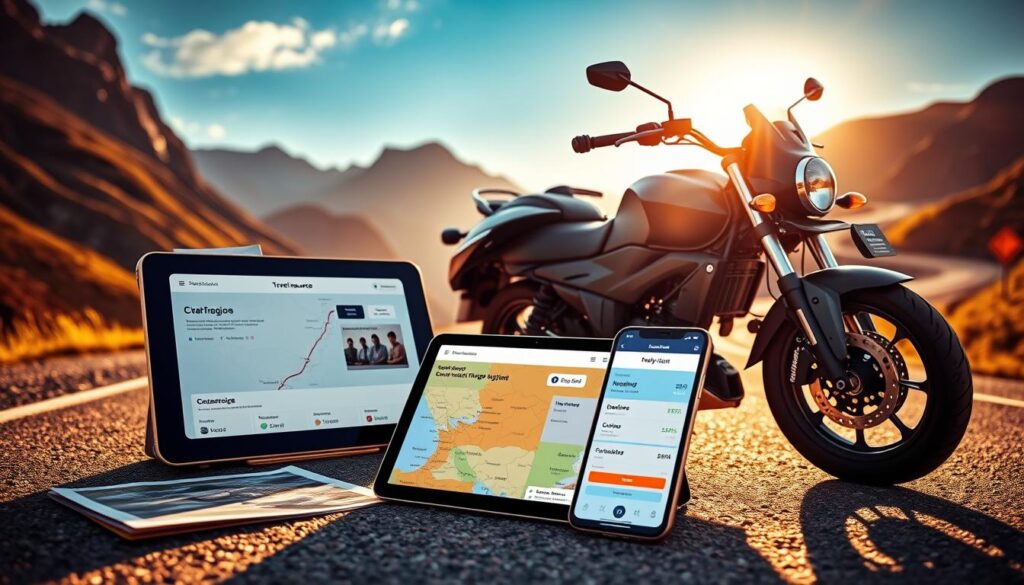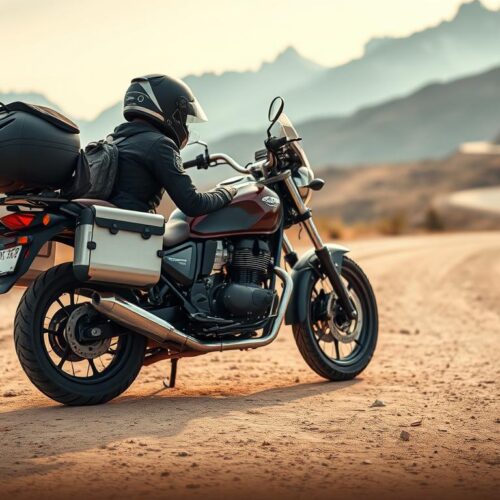Motorcycle touring is a thrilling way to explore the world. But, it comes with risks like accidents, theft, and illness. Travel insurance is your safety net, protecting your money and peace of mind.
When planning a trip, think about what insurance you need. Good insurance should cover medical costs, bike theft or damage, and trip cancellations. Some companies offer special motorcycle insurance packs with clear rules and limits.
Travel safety on a motorcycle means reading policy details carefully. Look for what’s not covered, deductibles, and how adventure sports are classified. Hospital bills in the U.S. can be very high, and getting back home can cost a lot too. So, getting the right insurance is crucial.
Before comparing insurance quotes, know what you need: your route, bike value, riding style, and budget. Research different providers and compare what they offer. Make sure your insurance covers motorcycle activities. Update your coverage if your plans or assets change.
Understanding Motorcycle Travel Insurance
Before you book a trip, it’s key to know what motorcycle travel insurance covers. Standard policies protect against medical costs, trip cancellations, and lost luggage. But, motorcycle insurance adds extra layers for riders, like emergency medical care and legal fees after an accident.
Make sure your policy mentions motorcycle touring or adventure use. Many insurers offer a Motorcycle Pack as an add-on. This pack covers theft or damage to your bike and gear, passenger protection, and riding on public roads.
Know what’s not covered. Policies usually exclude off-road riding, motocross, racing, and jumping. Damage to rental bikes is often treated differently than injuries to riders. Check engine size limits and if rental-bike damage is included in your policy.
Choose insurance based on your trip. Short, paved tours need different coverage than long, off-road adventures. If your trip includes technical trails or competitive events, check if adventure sports coverage is available.
Licensing and documentation are crucial. Insurers need valid motorcycle licenses and may ask for proof of riding experience. Not meeting these requirements can make claims invalid for theft, damage, or medical care.
Read policy definitions carefully. Terms like “insured person,” “covered events,” and “territorial limits” are important. Clear definitions help avoid surprises and let you compare policies from companies like Progressive, Allstate, and Allianz Travel.
Importance of Motorcycle Travel Insurance
Motorcycle touring can lead to accidents, injuries, theft, and sudden trip cancellations. Getting motorcycle travel insurance is crucial. It covers these risks, allowing you to ride with confidence.
Traveling abroad means facing heavy traffic, poor roads, and unfamiliar traffic rules. Insurers like Allianz or AIG might not cover emergency medical claims without motorcycle insurance. This makes travel safety a financial must, not just a buzzword.
Medical care in the U.S. can cost tens of thousands of dollars for a hospital stay. International repatriation and evacuation are even more expensive. Knowing why you need travel insurance helps avoid huge bills and ensures you get the care you need.
Insurance also offers emergency assistance and repatriation for serious injuries abroad. It can arrange hospital transfers, language help, and transport back home when local care is not enough.
Consider what you need covered, like medical expenses, roadside assistance, and theft. A clear comparison helps you see what each plan offers. This way, you can fill any gaps before you hit the road.
| Risk | What Insurance Covers | Why It Matters |
|---|---|---|
| Accidents and injuries | Medical costs, hospital stays, emergency evacuation | Prevents large medical bills and ensures timely treatment |
| Theft or vandalism | Replacement or repair of bike and gear | Limits financial loss and speeds up recovery after theft |
| Trip cancellation or interruption | Refunds for prepaid trips, transport changes | Protects prepaid costs when plans change unexpectedly |
| Roadside breakdown | Towing, on-the-spot repairs, local support services | Keeps you moving and reduces time stranded in risky areas |
| Repatriation | Medical transport home, coordination with hospitals | Ensures safe return when care abroad is inadequate |
Deciding to get travel insurance becomes clearer when you match risks to coverage. This match boosts your travel safety and lets you enjoy the ride without worry.
Types of Motorcycle Travel Insurance Policies

There are many types of motorcycle travel insurance for different trips. Standalone policies cover risks like crashes, theft, and getting help on the road. International policies are for when you ride across borders and need local protection.
Some plans let you add a motorcycle pack as an extra. Fast Cover’s Motorcycle Pack is an example. It works with Comprehensive, Standard Saver, and Frequent Traveller Saver policies. These packs often include theft and damage cover for bikes.
Other plans have riders for motorcycling. These riders cover medical for injuries, legal fees, and trip cancellations. Make sure motorcycling isn’t excluded or has limits.
Adventure sports insurance covers off-road or enduro rides. If you plan to ride technical trails, choose a policy that lists motorcycling or adventure sports. Check the limits and exclusions carefully.
When comparing, look at medical, liability, theft, legal fees, and trip cancellation coverage. Some insurers bundle motorcycling into higher-tier policies. Others offer specialized policies for long-distance or international rides.
Use a checklist to find the right policy. Check for cross-border liability, emergency medical limits, theft and recovery cover, and bike or rider age exclusions. This ensures your policy fits your ride and style.
Factors to Consider When Choosing a Policy
Start by thinking about your route and destination. Make sure your insurance covers you worldwide and includes medical repatriation. Also, check if it covers adventure sports and theft of your motorcycle and gear.
Before buying insurance, check your license needs. Some policies require a U.S. license and a valid permit from your country. Countries like Thailand and Vietnam might ask for an International Driving Permit or a local license.
Know the engine size limits of your insurance. Most plans cover bikes up to 125cc. If your bike is bigger, you might need a different policy or an add-on.
Choose a policy that fits your needs. Consider how long you’ll be traveling, the value of your bike and gear, and your budget. Decide if you prefer higher premiums or larger deductibles.
Look at customer service, what’s not covered, and the company’s reputation. Read the policy carefully to understand limits and emergency help. Make sure there’s 24/7 assistance and clear claims procedures.
Use the list below to guide your review:
- Destination risks and medical repatriation
- Theft and gear coverage
- License requirements and local laws
- Engine capacity limits and bike eligibility
- Premiums, deductibles, and coverage limits
- 24/7 emergency assistance and claims handling
By balancing these factors, you can find the right policy for your trip. Keep your licenses and policy details with you to avoid coverage disputes.
Evaluating Insurance Providers
Start by reading travel insurance reviews from motorcycle communities and forums. You’ll learn how providers handle emergencies and long tours. Look for comments on roadside assistance, medical evacuations, and claim settlements.
Check each insurer’s Product Disclosure Statement and eligibility rules. Note exclusions, limits, and sub-limits that affect riders. Confirm if the policy covers motorcycle touring, repatriation services, and rental bike damage. Watch for age limits and personal liability exclusions that some providers list in their terms.
Compare motorcycle travel insurance providers on price and coverage detail. Pay attention to deductibles, claim-handling speed, and extra benefits. Emergency hotlines, multi-policy discounts, and legal cover can make a big difference when you travel.
Assess insurer reputation through independent ratings and user feedback. Customer service responsiveness and claims turnaround matter most for travelers who face urgent issues abroad. You want a provider with clear contact options and prompt payouts.
Use the table below to compare key factors across providers. Focus on coverage features that match your itinerary and riding style. Keep notes from travel insurance reviews and community feedback as you decide.
| Provider | Motorcycle Touring Cover | Rental Bike Damage | Repatriation Services | Typical Deductible | Claims Turnaround |
|---|---|---|---|---|---|
| Allianz Global Assistance | Available in select plans | Covered with restrictions | Yes, medical evacuation included | $100–$500 | 7–14 days |
| World Nomads | Designed for riders and tours | Often included for short-term rentals | Emergency evacuation available | $50–$300 | 5–10 days |
| AXA Assistance | Optional add-on for motorcycles | May be excluded in some regions | Yes, repatriation cover offered | $100–$400 | 7–21 days |
| Generali Global | Touring options listed in PDS | Covered with higher excess | Included for major medical events | $150–$500 | 10–20 days |
When evaluating insurers, keep a short checklist. Verify emergency contact methods, read multiple travel insurance reviews, confirm exclusions in the PDS, and test customer service response before you buy.
Comparing Quotes from Different Insurers
When comparing quotes, don’t just look at the price. Check the medical limits, repatriation, theft or damage to your bike and gear. Also, see if trip cancellation or interruption is covered.
Make sure legal fees for incidents abroad are included. Also, check if adventure sports or motorcycle touring are covered. Look at policy rules on engine size, license needs, and age limits.
Read about what’s not covered, like off-road or competitive riding. Find out if you’re covered as a passenger. Also, see if rental vehicle excess applies to motorcycles.
Think about deductibles and whether an annual or single-trip policy is better for you. Be aware of extra costs for equipment, roadside help, or higher liability. Check the Product Disclosure Statement to match your plans and destinations.
Focus on the benefits, not just prices. Make a checklist of must-haves: medical cover, bike and gear protection, trip cancellation, legal fees, and adventure-sport coverage. This helps choose the right insurance for your trip.
Look at the insurer’s reputation and claims handling too. Read reviews for companies like Allianz, AIG, and World Nomads. A bit more money upfront might save you stress if you need to claim.
Keep all your quotes and Product Disclosure Statements. This helps spot key differences. It ensures you pick the right insurance for your trip and riding style.
Reading the Fine Print
Start by looking for travel insurance exclusions that could hurt you. Many policies don’t cover off-road riding, motocross, or racing. Riding drunk, without a helmet, or without the right license can also void your coverage.
Check if your policy excludes personal liability claims. Claims from using vehicles can be excluded from general travel policies. Make sure your license and country rules meet the insurer’s needs for long trips.
Ask about rental bike cover and excess relief. Some policies don’t cover rental bikes or offer no excess relief for them. Engine size limits are also common.
Look at limits, deductibles, and mid-trip changes. Coverage limits and deductibles affect how much you’re really protected. Clauses on ending your trip can leave you exposed if plans change.
Keep a checklist when comparing policies. Confirm exclusions for illegal acts and high-risk activities. Check if licensing, helmet use, and alcohol rules are included. See if liability from a motorcycle is covered or not.
If something seems unclear, ask for a clear answer before buying. Clear answers help avoid surprises and improve travel safety. Reading the fine print carefully helps you avoid hidden issues and costly misunderstandings.
Choosing Coverage Limits
Start by thinking about the likely medical costs and repatriation fees for your trip. In the United States, hospital bills can be very high. Make sure your coverage includes emergency care, air ambulance, and repatriation from remote places.
When renting a bike, check if your policy covers damage to the rental. Companies like Harley-Davidson Rentals and EagleRider might need a collision damage waiver. Look at sub-limits for theft, helmet replacement, and personal effects to avoid surprises.
Look at travel insurance limits for liability and legal fees in the places you’ll visit. Some areas have higher legal costs. Set your limits to protect against lawsuits and long legal battles.
Think about the trade-off between saving on premiums and higher deductibles. A bigger deductible means lower premiums but more out-of-pocket costs after a claim. Choose limits that cover major risks but fit your budget and comfort with unexpected costs.
Use the checklist below to compare options and decide what insurance to get before you ride.
| Coverage Item | Why It Matters | Recommended Minimum | Notes |
|---|---|---|---|
| Medical Expenses | Covers ER care, surgery and hospitalization | $250,000 for travel to high-cost countries | Increase if you have preexisting conditions or long rides in remote areas |
| Repatriation & Evacuation | Pays for air ambulance and return of remains | $50,000–$150,000 | Remote routes and international travel raise costs quickly |
| Liability & Legal Fees | Protects against third-party claims and defense costs | $500,000 combined single limit | Verify local minimums and choose higher limits for cross-border trips |
| Rental Motorcycle Damage | Covers collision and loss for rented bikes | $10,000–$30,000 or full CDW | Ask rental company about waivers; add policy if rentals are excluded |
| Theft & Personal Effects | Replaces stolen gear, luggage and electronics | $2,000–$10,000 | Separate sub-limits often apply to helmets and cameras |
| Deductible | Your out-of-pocket amount per claim | $250–$1,000 | Higher deductible lowers premium but raises immediate cost after accidents |
After setting your coverage limits, get quotes from trusted insurers and compare them. Match your travel insurance limits and motorcycle travel insurance limits to your trip, age, and riding style. This way, you can choose the right insurance with confidence.
The Claims Process Explained

After an accident or theft, call your insurer’s 24/7 emergency line right away. Carry a copy of your policy and emergency numbers. This quick action helps speed up the claims process and gets you the help you need.
Take photos and videos of the scene, get witness details, and obtain a police report for theft or serious accidents. For medical issues, get hospital records and medical reports. These are key pieces of evidence for your claim.
Insurers review each claim based on your policy. Riding without a license, being impaired, or breaking local laws can lead to claim denial. Always check what’s covered and what’s not before you ride.
If you need hospital care or urgent help, follow your insurer’s advice carefully. Their teams can help with transport, hospital communication, and paperwork. Ignoring their instructions can slow down your claim.
To add coverage during your trip, contact your provider for details and costs. Keep all receipts for emergency repairs, rentals, and medical expenses. A clear, detailed claim file with all documents helps speed up the process.
For more on handling accidents and paperwork, check out dealing with a motorcycle crash. This guide explains what insurers usually ask for and how to present your evidence effectively.
| Action | Why it matters | What to include |
|---|---|---|
| Call 24/7 emergency line | Starts the claims process and activates travel safety assistance | Policy number, location, brief incident summary |
| Document scene | Provides independent proof for insurers | Photos, videos, witness contacts, police report |
| Collect medical records | Supports medical and repatriation claims | Hospital notes, test results, bills, receipts |
| Preserve receipts | Verifies expenses for reimbursement | Repair invoices, rental fees, travel costs |
| Confirm legal compliance | Prevents denial of motorcycle travel insurance claims | Valid license, local permits, compliance evidence |
| Submit complete claim file | Speeds up assessment and payout | Claim form, supporting documents, signed statements |
Common Misconceptions About Motorcycle Insurance
Many think their standard travel policy covers all activities on a trip. But, that’s a common motorcycle insurance myth. Most travel policies don’t cover motorcycling unless you add a specific motorcycle or adventure pack. Also, rental damage is often not covered, leaving you with a big bill after an accident.
Another myth is that any driver’s license works overseas. Insurers usually need your U.S. license and a valid license for the country you’re riding in. Some countries require an International Driving Permit or a local license. And, carrying a passenger? Don’t assume they’re covered; you need a motorcycle add-on for that.
Low prices can be misleading. The cheapest policy might have limited coverage, lower liability limits, and many exclusions. Always read the product disclosure statement to know what’s included before you sign up.
When shopping, use this quick checklist. Check if motorcycling is excluded. Confirm the rules for rental damage. Make sure you have the right license for each country. And, ask if passengers and gear are protected.
These travel insurance facts can save you from surprises on the road. Knowing the truth about motorcycle travel insurance can make your trip safer and protect your wallet.
Tips for Maintaining Your Insurance
Always follow your policy’s rules when you ride. This means obeying local laws, wearing a helmet, and carrying the right documents. Keep a copy of your policy and emergency numbers handy for quick action if needed.
Let your insurer know if your trip plans change. Many will let you extend your trip if you ask ahead of time. Telling them quickly helps keep your insurance in place and avoids coverage gaps.
Read the rental agreement carefully when renting a motorcycle. Some policies might not cover rental bikes or the excess. Ask about collision waivers from places like Hertz or local firms to fill any gaps.
Don’t do things your policy says you can’t. Riding off-road, racing, or doing stunts is usually not covered. Staying within the rules helps avoid claim denials and keeps your insurance in good shape.
Check your policy before each trip and every year. Make sure your medical and repatriation limits are enough, especially for risky places. Regular checks ensure your insurance matches your travel plans.
Keep good records for claims. Save receipts, license copies, damage photos, and any police reports. Good records help speed up the claim process and strengthen your case.
Use safe travel tips while riding. Plan your route, tell someone your plans, and avoid bad weather and unknown areas at night. Safe riding lowers your claim chances and shows you’re a responsible rider.
Compare your policy before renewal. Higher limits for medical and repatriation might cost more but offer better protection. A careful renewal process keeps your insurance up to date and useful.
Helpful Resources and Tools

Start with official government travel advisories and embassy pages for destination-specific rules. These portals list visa, licence and entry requirements that affect your motorcycle travel insurance resources and legal obligations.
Visit touring forums like ADVrider and Horizons Unlimited to read first-hand insurer reviews and rider experiences. Forum threads often reveal practical tips on claims, exclusions and regional quirks that you won’t find in marketing materials.
Always read the insurer Product Disclosure Statement, or PDS, before you buy. The PDS shows exact policy wording, age limits, engine-capacity rules and eligibility details. Brands such as Fast Cover publish clear PDS documents for their motorcycle packs.
Use comparison tools to evaluate coverage features rather than chasing the lowest price. Comparison sites help you weigh excess levels, third-party liability, medical evacuation and trip interruption within your motorcycle travel insurance resources.
Carry both digital and printed copies of your policy, emergency assistance contacts, driving licence and international driving permit. In some countries authorities will ask for a physical international driving permit alongside your home licence.
For medical-cost estimates and repatriation rates, consult international medical assistance companies and your embassy. They provide benchmarks that help you assess the level of cover you need and which travel safety tools to prioritize.
Keep a checklist of travel safety tools for the ride: reflective vests, basic first-aid kit, emergency locator device and local SIM or satellite communicator. These items reduce risk and can influence insurer responses during a claim.
| Resource | What it gives you | How it helps |
|---|---|---|
| Government travel advisories | Entry rules, safety warnings, embassy contacts | Clarifies legal requirements and emergency support options |
| Insurer PDS documents | Policy wording, exclusions, eligibility criteria | Ensures you understand cover limits and claims process |
| Motorcycle forums (ADVrider) | Rider reviews, regional tips, insurer feedback | Offers real-world insight into claims and service quality |
| Comparison tools | Side-by-side policy feature comparisons | Helps you choose coverage that matches your risk profile |
| International Driving Permit guidance | Country-specific licence requirements | Prevents fines and ensures legal riding eligibility abroad |
| Medical assistance firms & embassies | Cost estimates, repatriation procedures | Supports decisions on medical cover and evacuation options |
| Travel safety tools checklist | Recommended gear and emergency contacts | Improves on-road safety and speeds up emergency response |
Conclusion: Finding the Right Coverage for You
When you plan a trip on two wheels, motorcycle travel insurance is key. It keeps you safe financially and gives you peace of mind. Start by looking for policies that cover touring and adventure riding.
Compare the medical, repatriation, and emergency assistance limits. Make sure they match the risks of your route.
Before you leave, check your licence needs. You might need a U.S. license, an International Driving Permit, or a local licence. Also, confirm engine-capacity limits and what riding activities are allowed.
Add necessary motorcycle packs or add-ons. Be clear about what’s not covered, like off-road use, racing, or riding under the influence. This way, you won’t face surprises.
Use a final checklist: read the Product Disclosure Statement carefully. Make sure it covers medical care, theft, rental damage, and personal liability. Carry your policy documents and emergency contacts with you.
Plan your deductibles and limits with destination risks in mind. Review your policy regularly. Keep searching until you find coverage that fits your adventure and travel safety needs.




